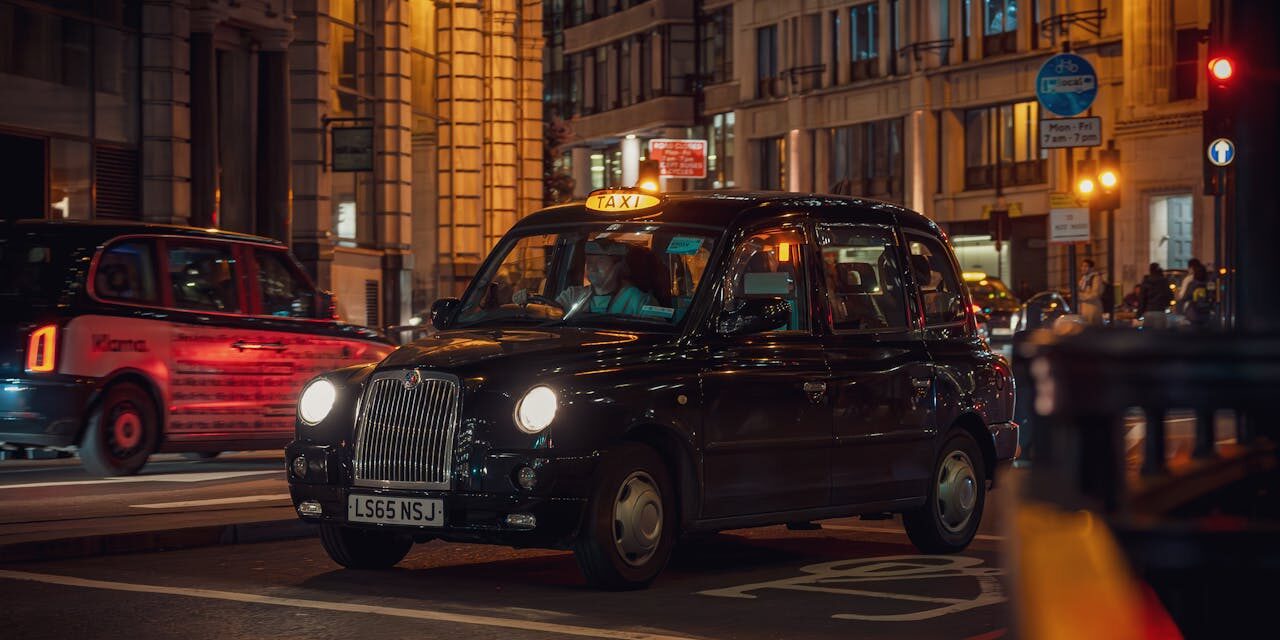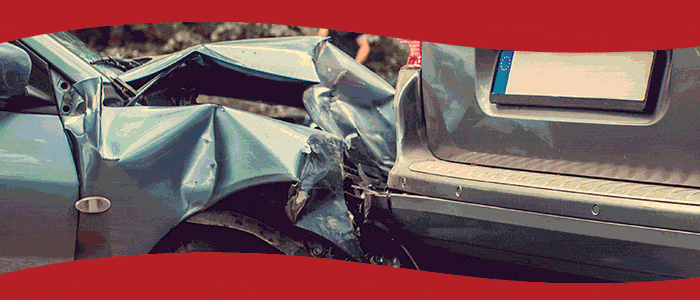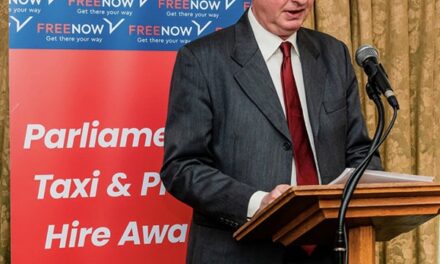This statistical release presents information on taxis and private hire vehicles (PHVs) in England as at 1 April 2024. This includes PHV operators and drivers who use app-based technology. However, we are not able to disaggregate which drivers are using these apps in the figures presented. The release also includes statistics under development on the fuel type and age of taxis and PHVs, which were first issued in 2022 and now have several years of data available.
Data for 2024 represent the position as at 1 April this year. This allows policy changes introduced on 1 April (the start of a new financial year) to be captured, so that the latest possible picture is presented in these statistics. Prior to the 2023 release, the data represented the position as at 31 March.
Since 2018, figures are updated every year through surveying each licensing authority (a unitary or lower tier authority) in England and Wales. Prior to that, the survey was conducted every other year. Some of the data are derived from other additional sources.
This release largely refers to England only, but data for Wales can be found in the associated tables.
Advertisement
This publication includes accredited official statistics, official statistics and official statistics in development. For more information, see the official statistics section.
Taxis and Private Hire Vehicles
Taxis, also known as hackney carriages, are available for immediate hire, can be hailed in the street (‘ply for hire’) or accept pre-bookings. Taxis have 2 types of licences, a vehicle licence (issued to the owner of the taxi) and a driving licence.
Private hire vehicles, also known as minicabs, must be pre-booked and cannot use taxi ranks. It is illegal for PHVs to ply for hire. PHVs have 3 types of licences: a vehicle licence, a driving licence and an operator licence.
Headline figures
The total number of licensed taxi and PHV vehicles and driver licences in England have both continued their long-term upward trend, reaching 313,000 and 381,100 respectively on 1 April 2024. The increase since 2023 has been driven by a 10.5% increase in the number of PHVs, reaching 256,600. The number of taxis has decreased over the same period by 1.4% to 56,400.
Summary
Trends since 2005 – Taxi and PHVs
Chart 1: Total licensed taxi and private hire vehicles and drivers: England, since 2005 – TAXI0102

Chart 1 is a line chart that shows how the number of licensed vehicles and drivers has changed over time. The number of licensed vehicles has been steadily increasing since 2005, apart from over the coronavirus (COVID-19) pandemic where numbers temporarily fell to a low of 251,000 in 2021 before resuming the upward trend. There were 313,000 licensed taxi and private hire vehicles in England in 2024, an 8.2% increase from 2023 and 70% increase from the 184,500 in 2005.
Chart 1 shows that there the number of driver licences held has been steadily increasing from 242,100 in 2005. This number dropped temporarily during the COVID-19 pandemic to 330,000 in 2022, before continuing the upward trend. There were 381,100 in 2024, an increase of 10% compared to the previous year, and a 57% increase compared to 2005.
Advertisement
The upward trend for both driver licences and vehicles is being driven by the PHV industry. The number of taxis and taxi drivers has fallen slightly (-1.4% and -7.4% respectively) since 2023, whilst the number of PHVs and PHV drivers has increased (10.5% and 13.6% respectively) over the same period.
Long term taxi trends
Chart 2: Licensed taxi vehicle numbers in London, and England and Wales outside of London, from 1972 – TAXI0101

Prior to 2005, the only data available relates to the number of licensed taxis and licensed taxi drivers for England and Wales as a whole. Other than for London, data at a lower geographical level is not available.
Chart 2 is a line chart that shows that since 1972 the numbers of licensed taxis in London, and in England and Wales outside of London, both broadly followed similar trends of increasing until 2015 before declining to the present day.
The number of taxis in England and Wales outside London reach a high of 58,800 in 2017, almost 5 times as many as the 12,400 in 1972. Since then, numbers have dropped to 45,800 in 2024, a similar level to what was seen in 2004 but still almost 4 times as many as when records began in 1972.
London follows a similar pattern, with a high of 22,500 in 2015. Again, the number of taxis in London has dropped over more recent years, falling back to 14,800 in 2024. This is still a 47% increase from the 10,100 in 1972.
Following the Transport Act 1985, the number of taxis outside of London increased as more district councils licensed taxis.
2024 summary
Table 1: Summary of 2024 taxi and private hire vehicle licensing figures compared with 2023 – TAXI0102
Advertisement
| Quantity | Thousands of vehicles or licences – London | Percentage change from 1 April 2023 – London | Thousands of vehicles or licences – England outside of London | Percentage change from 1 April 2023 – England outside of London | Thousands of vehicles or licences – England | Percentage change from 1 April 2023 – England |
|---|---|---|---|---|---|---|
| Both taxi and PHV driver licences | 0 | Not applicable | 6.2 | 26 | 6.2 | 26 |
| Dual taxi and PHV driver licences | 0 | Not applicable | 78 | 7 | 78 | 7 |
| PHV only driver licences | 106.2 | 5 | 156.6 | 21 | 262.8 | 14 |
| Taxi only driver licences | 17.4 | -5 | 16.7 | -10 | 34.1 | -7 |
| Total driver licences | 123.6 | 3 | 257.5 | 14 | 381.1 | 10 |
| PHV Operator licences | 1.7 | 10 | 14.6 | 9 | 16.3 | 9 |
| Total licensed taxis | 14.8 | -2 | 41.6 | -1 | 56.4 | -1 |
| Wheelchair accessible taxis | 14.8 | -2 | 15.6 | -5 | 30.4 | -3 |
| Total licensed PHVs | 92.6 | 3 | 164 | 15 | 256.6 | 11 |
| Wheelchair accessible PHVs | 0.4 | -10 | 5.2 | 12 | 5.6 | 10 |
| Total licensed vehicles | 107.4 | 3 | 205.6 | 11 | 313 | 8 |
Table 1 summarises the 2024 taxi and PHV licensing statistics. Figures for licensed vehicles, PHV operators and drivers are shown for London, England outside of London, and England.
Licensed vehicles
Chart 3: Licensed vehicles by type and area: England, since 2005 – TAXI0101

Chart 3 is a line chart showing that there were 313,000 licensed taxis and PHVs in England in 2024. Around a fifth (56,400) of these vehicles were taxis. The total number of licensed vehicles increased by 8.2% between 2023 and 2024, driven by a 10.5% increase in PHV numbers. The number of taxis fell by 1.4% over the same period.
As at 1 April 2024:
- there were 56,400 licensed taxis, a 1.4% decrease from 2023
- licensed taxis in London fell by 2.1% compared to 2023
- licensed taxis in England outside of London fell by 1.1% compared to 2023
- there were 256,600 licensed PHVs, a 10.5% increase from 2023
There was a much larger increase in PHVs in England outside of London compared to London, 15% and 3.4% respectively.
Licensing authorities (outside of London) are able to impose limits on the numbers of taxis licensed to operate within their area. However, they are unable to impose such limits on PHVs. In 2024, 66 licensing authorities (23% of licensing authorities with licensed taxis) applied a limit on the numbers of licensed taxis, with a further 9 setting limits either for some of the areas they covered, or some vehicle types. These figures have been broadly similar over the last couple of years.
In England as a whole, licensed vehicle numbers increased by 8.2% between 2023 and 2024. All regions saw an increase in the number of licensed vehicles compared to 2023. However, there was considerable variation between regions, with some regions seeing small increases in numbers, while others saw large rises. The number of licensed vehicles in the West Midlands increased by 20.1% between 2023 and 2024, mainly due to a large increase in Wolverhampton, a trend that has been seen year on year since 2017. The 2 neighbouring regions, North West and East Midlands both showed the smallest change in vehicle numbers outside of London, both increasing by 6.7% . More detail on trends in regions and individual local authorities can be found in the associated tables.
Licensed taxi and PHV vehicles per 1,000 people
Chart 4: Number of licensed taxis and private hire vehicles per 1,000 people by urban-rural classification, England 2024 – TAXI0105
Advertisement

In 2024, there were on average 5.5 licensed taxi and PHV vehicles per 1,000 people in England, similar to the 5.1 in 2023. Chart 4 is a stacked bar chart that shows that the number of licensed vehicles per 1,000 people generally decreases as areas become more rural. In London there were 12.1 vehicles per 1,000 people, compared with 2.5 in areas that were largely rural. These figures are broadly similar to 2023.
It is important to note that when talking about the number of licensed vehicles per 1,000 people in an area, this is the number of vehicles licensed by that authority and not the number of vehicles available for hire in that area.
Wolverhampton has had more licensed PHVs per 1,000 people than the rest of England and Wales over the last few years, reaching 109 per 1,000 people in 2024. This is 5 times more than the figure observed for all other licensing authorities, which have less than 20 licensed vehicles per 1,000 people. Differences between local authorities can reflect factors such as licensing policies and processes, as well as levels of provision. For example, it is sometimes the case that private hire vehicles can be licensed in one authority while operating primarily elsewhere. The large increase seen in licensed private hire drivers and vehicles by the City of Wolverhampton Council since 2017 is likely to be as a result of some of these factors. The differences in licensed taxis are less stark, with all licensing authorities having between 0 and 6.3 taxis per 1,000 people.
Driver licences
As at 1 April 2024, there were 381,100 driver licences in England, 34,800 (10%) more than in 2023. Of the total licences, 69% were PHV-only licences, 9% were taxi-only licences and 20% were dual taxi and PHV licences, a similar split to the previous year. Dual licences allow the holder to drive both taxis and PHVs without needing to hold 2 separate licences. In 2024, 2% of licences were instances were both a Taxi and PHV only licence were issued to the same individual.
The regional picture varied considerably when looking at the change in the number of licensed drivers between 2023 and 2024. While the West Midlands saw a large increase (26.5%), again mainly due to a large increase in Wolverhampton, most other regions saw increases of between 7% and 12%, with the exceptions of the North East (16.8%) and the South West (5.9%). More detail on trends in regions and individual local authorities can be found in the associated tables.
Licensed PHV operators
PHV operators need to be licensed to accept bookings and dispatch vehicles to customers. The number of licensed PHV operators in England increased by 8.9% between 2023 and 2024 to 16,300, returning to the upward trend seen before the pandemic. The picture is similar across the country, with London seeing an increase in PHV operators of 9.9% to 1,700 operators. England outside of London saw an increase of 8.8% to 14,600.
In the year ending 31 March 2024, 3,610 applications were made by new PHV operators (either new companies, or existing operators not already licensed by that licensing authority). This represented an increase of 30% from the previous year, and is likely to indicate continued recovery in the sector following the COVID-19 pandemic.
Accessibility
In England, 11.5% of all licensed vehicles were wheelchair accessible in 2024. Compared to 2023 the proportion of wheelchair accessible taxis remained similar at 53.9%. The proportion of PHVs that were wheelchair accessible in 2024 has remained lower than Taxis at 2.2%, this is similar to 2023.
Advertisement
Map 1: Proportion of licensed vehicles that were wheelchair accessible in 2024 by licensing authority, England – TAXI0104

As Map 1 shows, in England outside of London, there was considerable variation in the proportion of licensed vehicles that were wheelchair accessible. More local authorities in the West Midlands had ‘30% or more’ of their taxi and PHV fleets wheelchair accessible, compared to the other regions of England. There was no clear geographic variation in the number of authorities in which ‘less than 5%’ of all licensed vehicles were wheelchair accessible.
In London, all 14,800 taxis were wheelchair accessible, as required by Transport for London’s ‘Conditions for Fitness’ taxi licensing policy. In the rest of England outside of London, 37.6% of taxis were wheelchair accessible. In several other large cities, such as Birmingham, Liverpool and Manchester, all of the licensed taxis were wheelchair accessible.
In London, only 0.4% of PHVs were wheelchair accessible, whereas in the rest of England this figure was slightly higher at 3.2%. Generally speaking, urban areas tended to have higher proportions of wheelchair accessible taxis, but lower proportions of wheelchair accessible PHVs. In rural areas, the proportions of wheelchair accessible taxis and PHVs were similar.
Definition
The Rural Urban Local Authority Classification categorises districts and unitary authorities on a six point scale, based on the share of the resident population that resides in rural areas. The 6 categories are:
- Mainly Rural (80% or more of the population resides in rural areas)
- Largely Rural (between 50% and 79% of the population resides in rural areas)
- Urban with Significant Rural (between 26% and 49% of the population resides in rural areas)
- Urban City and Town
- Urban with Minor Conurbation
- Urban with Major Conurbation
Some areas are unable to provide numbers of wheelchair accessible taxis and or PHVs. In 2024, Broadland were unable to provide numbers.
Accessibility policies
Training requirements (TAXI0110)
The increase in the number of authorities requiring disability awareness training for taxi and PHV drivers has continued in 2024. The number of authorities requiring disability awareness training for taxi drivers has increased from 43% in 2019 to 67% in 2024, while the number of authorities requiring disability awareness training for PHV drivers has increased from 41% to 65% over the same period.
Advertisement
Wheelchair policies (TAXI0110)
As at 1 April 2023, 67% of authorities required all or part of the taxi fleet to be wheelchair accessible, a small increase from 64% in 2019. However, only 5% of authorities required all or part of the PHV fleet to be wheelchair accessible in 2023. This question was not asked of authorities in 2024. In 2024, 98% of authorities maintain a list of wheelchair accessible taxis in accordance with section 167 of the Equality Act 2010 (an increase from 72% in 2019), while 94% maintain a list of wheelchair accessible PHVs (an increase from 62% in 2019).
Equality Act 2010 prosecutions in England and Wales
Background information on prosecutions data
The figures relate to defendants for whom these offences were the principal offences for which they were dealt with. When a defendant has been found guilty of 2 or more offences it is the offence for which the heaviest penalty is imposed. Where the same disposal is imposed for 2 or more offences, the offence selected is the offence for which the statutory maximum penalty is the most severe.
This is bespoke analysis from the Criminal Justice System quarterly statistical series, year ending December 2023.
Chart 5: Prosecutions for offences by taxi and PHV drivers and operators under the Equality Act 2010, England and Wales, 2014 to 2023

Chart 5 is a line chart that shows a rolling average of the number of prosecutions for offences committed by taxi and private hire vehicle drivers and operators in relation to sections 168 and 170 (assistance dog refusals by taxi and PHV drivers), and section 165 (wheelchair user discrimination by taxi and PHV drivers) in England and Wales. In the year ending 31 December 2023, there were 11 prosecutions. This is a large increase from the 4 seen in 2022 but is in line with levels seen in previous years. Figures for 2020 onwards have all been considerably lower than those seen before the pandemic, with 47 prosecutions taking place in 2019.
In the 10 years from 2014 to 2023, the majority of prosecutions were for failing to accept bookings to carry assistance dogs (61%). While it is not possible to calculate a precise conviction rate, based on the ratio of prosecutions to convictions it appears that the conviction rate has been around 80% over the last 10 years.
Safeguarding policies
There were 263 taxi and PHV licensing authorities in England as at 1 April 2024. However, for the 2024 survey, responses were received separately from the 3 non-Metropolitan districts that make up the unitary authority of Westmorland and Furness, which was formed on 1 April 2023. The 4 districts that make up the new unitary authority of Somerset also provided separate returns for the 2024 survey. This was because these districts were unable to provide a single response, as they still had different licensing policies in place as at 1 April 2024 due to transitional arrangements following the creation of the new unitary authorities.
Advertisement
There were also 3 authorities that did not have any taxis licensed as at 1 April 2024, these authorities did not have active policies in place for all the questions asked so the total number of taxi authorities varies between questions.
As a result of these factors, the numbers of authorities quoted below does not match the total number of licensing authorities that exist.
Child sexual abuse, child sexual exploitation awareness, and county lines training (TAXI0109)
As at 1 April 2024, the vast majority of authorities required taxi drivers (96% or 257 out of 267) and PHV drivers (96% or 258 out of 268) to complete child sexual abuse (CSA) or child sexual exploitation (CSE) awareness training. These proportions have increased from 70% (for both taxi and PHV drivers) in 2018. 73% of licensing authorities required both CSA and CSE training, and county lines training, an increase from 64% last year.
Security checks (TAXI0109)
All authorities required an enhanced DBS (Disclosure and Barring Service) security check and barred list checks for taxi and PHV drivers, the same as last year. The proportions of authorities requiring enhanced DBS and barred list checks has grown from 80% (for both taxi and PHV drivers) in 2017.
CCTV (TAXI0108)
As at 1 April 2024 8% of authorities had a requirement for all licensed taxis to have CCTV fitted (21 out of 266) and 7% had a requirement for all licensed PHVs to have CCTV fitted (20 out of 268). These represented a slight increase from the previous year. Of the authorities with the CCTV requirement, 17 had a requirement for the CCTV to have the facility to record audio in taxis and PHVs.
Almost all of the authorities without the CCTV requirement did allow licensed vehicles to have CCTV fitted. Only 1 authority did not allow licensed taxis to have CCTV fitted. The equivalent figure for PHVs was 2 authorities.
National register of revocations, refusals and suspensions (use of NR3S database) (TAXI0118)
National Register of Refusals, Revocations and Suspensions (NR3S)
The National Register of Refusals, Revocations and Suspensions (NR3S) is an operational database maintained by the National Anti-Fraud Network (NAFN). Licensing authorities are able to search the database to check whether a driver who is applying for a licence has previously had their licence removed, revoked or suspended by another authority, and can enter information on drivers whose licences they have refused, revoked or suspended.
Advertisement
The data are based on all searches and entries in the database carried out by licensing authorities. The figures shown are therefore management information, and not official statistics.
Use of the NR3S database was optional for licensing authorities during the year ending 31 March 2023. Use of the database has since been made mandatory in England (but not Wales) from April 2023 onwards. Prior to this, licensing authorities received access to the database at different times. Therefore caution should be exercised when attempting to make any comparisons between authorities.
Since use of the database is now mandatory in England, we are currently assessing the demand for this data and are proposing to cease publication of table ‘TAXI0118’ in future. We welcome any feedback you may have on this proposal.
In the year ending 31 March 2024, there were 187,600 searches of the NR3S database by licensing authorities in England, which equated to approximately 0.5 searches per licensed driver in England. Over the same period there were 8,200 entries in the database, which equated to around 0.02 entries per licensed driver.
There are several reasons why numbers may differ between authorities each year, such as not having access to the database at the time, or not revoking, refusing or suspending any licences during the year.
Taxi and PHV drivers
Background information on taxi driver data
Information in this section is based on the Labour Force Survey (LFS), a large study of the employment circumstances of the UK population, run by the Office for National Statistics (ONS).
The drivers in this section are defined using the Standard Occupational Classification system, SOC 2020, as “Taxi and cab drivers and chauffeurs” (code 8213), which will contain taxi drivers, PHV drivers and chauffeurs. The respondent reports their occupation to the interviewer and is then classified in this way during the interview, so the exact occupation of each respondent cannot be determined. As part of the interview respondents are asked whether they are employed or self-employed, but this is self-reported and may differ to their status under employment legislation.
Advertisement
These data differ to the rest of this release in that they refer to those who self-report their current occupation as being a taxi or PHV driver. It is possible for a person to hold a licence and not work as a driver, or for a person to not hold a licence but still claim to work as a driver.
Chart 6: Number of “Taxi and cab drivers and chauffeurs”, England, 2009 to 2024 (Labour Force Survey)

Chart 6 is a line chart that shows the number of “taxi and cab drivers and chauffeurs” in England between 2009 and 2024. Between 2009 and 2019 the number of “taxi and cab drivers and chauffeurs” in England fluctuated between 160,000 and 214,000. This fell between 2019 and 2021, due in part to the COVID-19 pandemic. Numbers seem to be stabilising again now at a lower level, 132,916 in 2024.
Who drives taxis and PHVs?
The majority of drivers were male (93.6%) in 2024. This proportion has been higher than 90% for all of the last 10 years.
Chart 7: Age profile of “Taxi and cab drivers and chauffeurs”, England, 2013 and 2024 (Labour Force Survey)

The average age of a driver was 48 years old in 2024, which was broadly in line with previous years. Chart 7 is a bar chart that shows that 22% of drivers were aged under 40, while those aged 60 or over also made up 18% of drivers. There has been a change in the age profile of drivers over the past 10 years, with a slightly smaller proportion of younger drivers and a larger proportion of drivers over the age of 40.
In 2024, the 2 main ethnic groups of drivers were Asian or Asian British, and White. These comprised 42.1% and 41.5% of drivers respectively. This compares to 29% and 63% respectively in 2010.
The proportion of self-employed drivers in 2024 (89.1%) has increased since 2010, when this figure was 76%. The proportion of part-time drivers (17.2%) appears to have fallen slightly in recent years.
Advertisement
Taxi and PHV passengers
National Travel Survey
The National Travel Survey (NTS) is a household survey of personal travel by residents of England travelling within Great Britain, from data collected via interviews and a seven-day travel diary. The COVID-19 pandemic from March 2020, had a substantial impact on travel trends since 2020 and has affected the operation of this survey. Fieldwork for the NTS 2022 survey continued to be impacted by the coronavirus pandemic, with data collection operating using the same knock-to-nudge method as in 2021 for the first 3 months of 2022 due to the emergence of the Omicron variant in late 2021. From April onwards, the survey returned to operating a face-to-face methodology with a phone back-up where this was not possible.
Data from the NTS can be used to analyse the users of taxis and PHVs. Note that data collected on specific travel by taxi or PHV cannot identify which type of service was used or if app-based technology was used to hail or book.
Chart 8: Average number of taxi and PHV trips taken per person per year, England, 2002 to 2022 – NTS0303

Chart 8 is a line chart that shows the average number of taxi or PHV trips taken per person per year between 2002 and 2022. There is a very slight long-term downward trend over the period 2002 to 2019, with trips fluctuating between 9 and 12 trips per person per year over this period.
In 2022, the average number of trips taken per person by taxi or PHV was 8, and the average distance travelled per person by taxi or PHV was 54 miles. This was up from an average of 7 trips and 34 miles in 2021. Whilst the average number of trips per person by taxi and PHV has remained lower than 2019 (when it was 11 trips per person), the average distance travelled has returned to the range seen over the last 20 years (50 to 62 miles).
The average taxi or PHV trip lasted 22 minutes in 2022, a 12% increase from last year and a return to the slow upward trend seen over the last 20 years. In 2002, the average taxi or PHV trip lasted 17 minutes.
Why do people travel by taxi or PHV? (NTS0409)
Education:
Advertisement
Education or escort education trips include those travelling for education and trips taken to escort someone else for education. In the context of trips taken by taxi or PHV, this would include a parent and child both taking a taxi or PHV to a school, college, or other place of education.
Almost half (46%) of trips taken by taxi or PHV in 2022 were taken for leisure purposes, bringing it closer to the proportion seen in the years prior to 2021. The other common reasons for trips in 2022 were:
- commuting (15%)
- shopping (12%)
- personal business (11%)
- education (10%)
These are broadly similar to the proportions seen in 2021, apart from shopping which has decreased from 17%.
How often do people use taxis or PHVs?
Chart 9: Frequency of taxi or PHV usage, England, 2021 and 2022 – NTS0313

Chart 9 is a stacked bar chart that shows the frequency of taxi or PHV usage in England in 2021 and 2022. Most people (64%) rarely used a taxi or PHV in 2022 (used once or twice a year or less, or never). This figure was lower in 2022 than in 2021, when it reached a high of 70%. In previous years in the series, this has consistently been around 60%. In 2022, around 16% of people travelled by taxi or PHV at least once a month but less than once per week, and 7% of people travelled by taxi or PHV at least weekly. These figures have both fallen since 2019, when they were 19% and 9% respectively, but figures for 2022 do show some recovery compared to 2021. Prior to 2019, these figures were stable for many years.
Who uses taxis and PHVs?
Mobility difficulties:
The NTS definition of having a mobility difficulty is based on those adults who responded to say they have difficulties travelling on foot, by bus or both.
Mobility difficulties
Chart 10: Taxi or PHV trips per person per year, by mobility difficulty, England, 2007 to 2022 – NTS0709
Advertisement

Chart 10 is a line chart that shows the average number of taxi or PHV trips taken per person per year between 2007 and 2022 with and without mobility difficulties. As in previous years, in 2022 the average number of trips taken by taxi or PHV was higher for those with mobility difficulties (17 trips per person per year) compared with those with no mobility difficulties (8 trips per person per year).
Compared to the figure for 2021, these figures for 2022 show an increase in the number of trips taken by those with mobility difficulties (from 10 to 17 trips per person per year). This brought it back in line with the range seen since 2007 (16 to 23 trips per year). There was a 17% increase in the number of trips taken by those without mobility difficulties in 2022 compared with 2021, from 6 to 8 trips per person per year, again this is more in line with the long-term trend.
In 2022, average taxi or PHV usage accounted for 3% of all trips for those with mobility difficulties, compared to 1% for those without mobility difficulties. These proportions have remained broadly stable since 2007.
Age and sex
Chart 11: Taxi or PHV trips per person per year, by sex and age, England, 2022 – NTS0601

Chart 11 is a bar chart that shows that in 2022, up to the age of 29, males took more trips by taxi or PHV than females of the same age. This is the opposite pattern for those aged 30 and over, where females took more trips than males. Overall, there was little difference in the number of trips taken by males and females (both taking 8 trips per person per year). However, males travelled further per person by taxi and PHV (62 miles) than females (47 miles).
Car access (NTS0702)
In 2022, on average, people in households without access to a car made around 5 times as many taxi or PHV trips as those with access to a car (25 trips per person compared to 5 trips per person respectively), and travelled roughly 3 times as far (127 miles per person compared to 41 miles per person respectively).
Compared to 2021, the number of trips taken and distance travelled has increased for both those with access and without access to a car.
The overall pattern of those without access to a car making more trips and travelling further by taxi and PHV has remained broadly stable since 2002.
Advertisement
Household income (NTS0705)
In 2022, the average number of trips taken by taxi or PHV varied across income quintiles, more trips were taken by households with a lower income (6 trips by those in the highest income quintile, and 10 trips by those in the lowest income quintile). There was no clear trend in distance travelled by income quintile.
How far are taxi or PHV trips? (NTS0308)
In 2022, 85% of taxi or PHV trips were for journeys of less than 10 miles. This was similar to previous years. Compared to the average for all other modes of transport, taxi trips were less likely to be less than 1 mile.
The majority of journeys by taxi and PHV (62%) were between 2 and 10 miles, this is the same as in 2021.
Fuel type and age of taxis and PHVs
About these official statistics in development:
These statistics are official statistics in development, reflecting the fact that they are new, innovative statistics that are still undergoing development, with an intention to develop them further in future years. We would welcome feedback on these statistics and how they might be developed further in future to meet user needs. There are some known limitations of these statistics, and these should be considered when reviewing the data.
About the dataset
In 2024, these data have been compiled by matching the Taxi and PHV centralised database with the Driver and Vehicle Licensing Agency (DVLA) vehicle database. This allows the taxi or PHV licensing status of vehicles to be matched with vehicle characteristics (such as date of first registration and fuel type).
There are some known limitations with this approach. Firstly, the Taxi and PHV centralised database is maintained centrally but updated by individual licensing authorities. The frequency and quality of updates will vary across licensing authorities. Administrative errors and omissions are likely to make these figures an underestimate of the total taxi and PHV fleet, with this being more of an issue for some licensing authorities than others. For this reason we are not able to publish robust estimates below regional level at this stage.
Secondly, cases where vehicles have changed licence type from taxi to PHV, or vice versa, have been removed from the dataset to minimise the risk of duplication. This is also true where the licensing authority with which a vehicle is licensed has changed. This therefore means that the dataset does not include this sub-section of the overall fleet.
Advertisement
Therefore while the analysis generally gives a good indication of the characteristics of the taxi and PHV fleet in England, it represents a large proportion of the fleet rather than every vehicle in it. The proportion of all taxi and private hire vehicles represented in the dataset has fluctuated between 80 and 90% between 2020 and 2024.
The analysis that is presented in the publication is therefore at national and regional level, as it is not currently possible to produce robust figures at local authority level. Caution should also be taken in interpreting small changes over time at regional level, as in some regions there have been changes in coverage over the period 2020 to 2024. The regions are determined by the postcode of the registered keeper in the DVLA database. It is important to note that this is not the same as the owner or the driver of the vehicle. More information can be found in the quality report.
Given that the data represent only a subset of the overall taxi and PHV fleet, the data are also presented as proportions rather than absolute numbers. It would not be appropriate to present absolute numbers when it is known that they would be an underestimate of the true totals.
In future years it is intended that the robustness of the data will improve further. We will endeavour to produce additional analysis and insights where possible.
Fuel type of taxis and PHVs – (TAXI0115)
Definitions
Full definitions of the main fuel types of vehicles can be found in the ‘notes and definitions’ section of the Department for Transport’s (DfT) vehicle licensing statistics.
A diagram showing the key properties of the main fuel types can be found in the DfT vehicle licensing statistics release.
To produce these statistics on fuel types for taxis and PHVs, the following definitions have been used:
Advertisement
- all hybrid: this includes hybrid-electric, plug-in hybrid electric, and range-extended electric vehicles
- battery electric: this includes fully electric vehicles only
Chart 12: Taxi and PHV fleet by fuel type, England, 2020 to 2024

Chart 12 is a line chart that shows that as at 31 March 2024, for the taxi fleet in England, the most common fuel type category was petrol and diesel (71%). Hybrid vehicles were 28% of the fleet, and 0.9% of the fleet were battery electric vehicles.
Over the period 2020 to 2024, the proportion of taxis using petrol and diesel has fallen (from 89% in 2020 to 71% in 2024). The proportion of hybrid vehicles has more than doubled (from 10% in 2020 to 28% in 2024), and the proportion of battery electric vehicles has increased four-fold (from 0.2% in 2020 to 0.9% in 2024).
Chart 12 also shows that as at 31 March 2024, for the PHV fleet in England, the most common fuel type category was petrol and diesel (46%). Hybrid vehicles were a close second at 44% of the fleet, and 8.8% of the fleet were battery electric vehicles.
Over the period 2020 to 2024, the proportion of PHVs using petrol and diesel has fallen (from 65% in 2020 to 46% in 2024). The proportion of hybrid vehicles has increased (from 34% in 2020 to 44% in 2024), and the proportion of battery electric vehicles has increased ten-fold (from 0.8% in 2020 to 8.8% in 2024).
The taxi and PHV fleet has a different mix of fuel types compared with the overall car fleet. DfT vehicle licensing statistics (VEH1103) shows that as at 31 March 2024 in England:
- 89.2% of licensed cars were petrol and diesel
- 7.5% of licensed cars were hybrid vehicles (including plug-in hybrid)
- 3.2% of licensed cars were battery electric vehicles
This means that compared to the car fleet, the taxi fleet has around 4 times the proportion of hybrid vehicles (28%), but around a third of the proportion of battery electric vehicles (0.9%).
For PHVs, the comparison is somewhat different. Compared to the overall car fleet, the PHV fleet has around 6 times the proportion of hybrid vehicles (44%), and around 3 times the proportion of battery electric vehicles (8.8%).
Advertisement
Within petrol and diesel vehicles, petrol cars were far less common in both the taxi fleet (2.8% of all vehicles) and the PHV fleet (5.6% of all vehicles) than in the overall car fleet (58% of all vehicles). Diesel vehicles were considerably more common in the taxi and PHV fleets than in the overall car fleet. This is particularly true for taxis, where diesel vehicles make up more than two-thirds of the fleet.
In other words, amongst taxis and PHVs, diesel and hybrid electric vehicles were more common than for the car fleet as a whole, while petrol vehicles were less common. A higher proportion of PHVs (8.8%) were either battery electric than for cars as a whole (2.8%), but the proportion of taxis (0.9%) that were battery electric was lower than both PHVs and the general car fleet.
Values in Chart 12 may not sum to 100% due to rounding, and the exclusion of other fuel types. Other fuel types would include alternative fuels such as hydrogen. These comprised less than 1% of both taxis and private hire vehicles (PHVs) in all years between 2020 and 2024.
Age of taxis and PHVs – (TAXI0116)
How age of vehicle is calculated
The age of vehicle is calculated based on the date of first use of the vehicle. This is usually when it was first registered with the Driver and Vehicle Licensing Agency (DVLA). However, the date of first use is typically unknown for imported vehicles and pre-1973 vehicles that were unregistered in 1973 but have subsequently been registered again. All of these vehicles will be older than their first registration date and therefore are classed as ‘unknown’ in this analysis.
Chart 13: Taxi and PHV fleet by age of vehicle, England, 2020 to 2024

Chart 13 is a line chart that shows the proportion of the taxi and PHV fleet in each age bracket between 2020 and 2024. For the taxi fleet, 51% of taxis were between 5 and 10 years old, and 29% aged 10 years and over. The PHV fleet was generally slightly younger than the taxi fleet, with 76% of vehicles under 10 years old, compared with 69% for taxis.
Over the period 2020 to 2024, for both taxis and PHVs, the proportion of vehicles aged under 5 years has decreased, and the proportion of vehicles aged between 5 and 10 years has increased. The proportion of vehicles aged 10 years and over has not changed much over the period 2020 to 2024.
Advertisement
The average age of a taxi in England as at 31 March 2024 was 7.3 years, whereas the average age of a PHV was 5.7 years. These figures were both lower than for all cars, with DfT vehicle licensing statistics (VEH1107) showing that as at 31 December 2023, the average age of cars in England was 9.5 years. This appears consistent with the higher mileage that most taxis and PHVs are likely to do, and also with the requirement to meet safety and emissions requirements, which are sometimes more stringent for taxis and PHVs than for private cars.
Fuel type – regional breakdown
In England outside of London, 83% of taxis were petrol or diesel as of 31 March 2024. In London the equivalent figure was lower at 44%. This is mainly because London has a relatively large proportion of range extended electric taxis (a sub-type of hybrid vehicle), which comprise more than half (54%) of London’s taxis, whereas this fuel type is not common outside of London. The proportion of battery electric taxis in London (1.3%) is now similar to that in England outside of London (1.1%). The differences between London and the rest of England are likely to reflect that since January 2018, all new taxis in London were required to be zero emission capable under Transport for London licensing requirements.
In addition to differences between London and the rest of England, there were also some other regional differences in the fuel type of taxis. For example, in England outside of London, the proportion of the fleet that was petrol or diesel varied between 76% in the South East and East Midlands to 90% in the West Midlands.
The proportion of PHVs that were petrol or diesel was lower in London (28%) than England outside of London (59%). London had a correspondingly higher proportion of hybrid electric PHVs (52% versus 39% in the rest of England).
The North East had a particularly high proportion of petrol or diesel PHVs at 79%, whereas in other regions such as Yorkshire and the Humber (36%), this figure was much lower. Regions with a lower proportion of diesel PHVs tended to have more hybrid electric ones.
Chart 14: Taxi and PHV fleet by fuel type, London and England outside of London, 2020 to 2024

Chart 14 is a line chart that compares how the proportions of different fuel types of taxis and PHVs have changed over time in London with those proportions in England outside of London.
Taxis
The proportion of battery electric taxis has increased over the period from 2020 to 2024 in both London and England outside of London, although remains a small proportion of the fleet in both areas. The rate of increase has been noticeably faster in London (from 0.1% in 2020 to 1.3% in 2024) than in England outside of London (from 0.2% in 2020 to 0.8% in 2024).
Advertisement
Over the period from 2020 to 2024, the proportion of hybrid taxis has more than doubled in both London (from 22% in 2020 to 54% in 2024) and in England outside of London (from 6.2% in 2020 to 16% in 2024).
In both locations, there has been a gradual decline in the proportion of petrol and diesel taxis, corresponding with the increase in hybrid taxis over the period 2020 to 2024. The impact of battery electric vehicles on this trend is relatively modest.
PHVs
The proportion of battery electric PHVs in London was more than 14 times higher than the proportion in 2020 (from 1.2% to 20%), and has quadrupled over the same period in England outside of London (from 0.3% to 1.2%).
The proportion of hybrid PHVs decreased slightly over the period 2020 to 2024 in London (from 55% in 2020 to 52% in 2024, after peaking at 57% in 2021), but has more than doubled over the same period in England outside of London (from 16% to 39%).
In both locations, there has been a gradual decline in the proportion of petrol and diesel PHVs over the period 2020 to 2024. In England outside of London, this is primarily driven by increases in hybrid PHVs. However, in London, this trend is primarily driven by increases in battery electric PHVs.
Age composition – regional breakdown
Chart 15: Taxi and PHV fleet by age of vehicle, London and England outside of London, 2020 to 2024

Chart 15 is a line chart that compares how the age compositions of the taxi and PHV fleets have changed over time in London with how those age compositions have changed in England outside of London.
Taxis
The age of the taxi fleet has decreased over the period from 2020 to 2024 in London, but has increased in England outside of London.
Advertisement
In London, the proportion of the taxi fleet aged 10 years and over decreased from 33% in 2020 to 21% in 2024. In England outside of London, the proportion of the taxi fleet aged 10 years and over increased from 29% in 2020 to 33% in 2024.
PHVs
The age of the PHV fleet has increased over the period from 2020 to 2024 in London. There was insufficient evidence of a change in age composition over this period in England outside of London, due to the increase in the proportion of vehicles of unknown age (from 2.2% in 2020 to 9.4% in 2024).
In London, the proportion of the PHV fleet aged 10 years and over showed little change between 2020 and 2024. However, the proportion of the PHV fleet between 5 and 10 years increased in London from 38% in 2020 to 57% in 2024, corresponding with a decrease in the proportion aged under 5 years (from 46% in 2020 to 27% in 2024).
There were some noticeable differences in the age of the taxi and PHV fleet by region as at 31 March 2024. The average age of a taxi varied from 5.7 years in London to 9.9 years in the North West. The average age of a PHV varied from 4.8 years in London to 7.2 years in the North West.
Fuel type and age of vehicle combined (TAXI0114)
When combining fuel type and age of vehicle, for both taxis and PHVs it is apparent that petrol and diesel vehicles tend to be older on average than other fuel types. This reflects the fact that some of the other fuel types are newer technologies.
As at 31 March 2024, in England:
- the average age of diesel taxis was 8.7 years
- the average age of battery electric taxis was 3 years
- the average age of diesel PHVs was 7.3 years
- the average age of battery electric PHVs was 2.2 years
Vehicle model
What is meant by vehicle model
Vehicle models presented here use the generic model from the DfT vehicle licensing statistics, which are groupings of specific models to help compare models on the road.
Advertisement
The most common models of taxi as at 31 March 2024 were the:
- London Taxis International TX4 (16%)
- London Electric Vehicle Company TX (10%)
- Mercedes Vito (8%)
- Skoda Octavia (6%)
The most common PHV models were the:
- Toyota Prius (20%)
- Toyota Auris (6%)
- Mercedes E class (6%)
- Skoda Octavia (6%)
The most common models of both taxis and PHVs are unchanged from 31 March 2023 with proportions also remaining broadly similar to previous years.
About these statistics
Uses and users of these statistics
These statistics are used within DfT to inform the development and monitoring of policy relating to taxis and PHVs (for example monitoring how many taxis and PHVs are wheelchair accessible) and for ministerial briefing or to answer public enquires.
Outside DfT, the statistics are of interest to various industry bodies and provide information for licensing authorities to compare themselves with other areas.
Strengths and weaknesses of the data
The data collected will cover PHV operators and enlisted drivers who use app-based technology, such as Uber. However, we are not able to disaggregate which drivers are using these apps in the figures presented. More information can be found in the quality report.
Official statistics
This publication is a compendium of accredited official statistics, official statistics, statistics in development, and statistics that fall outside the scope of official statistics. The type of statistics presented is detailed in Table 2 below.
Table 2: Categories of statistics presented in this publication
Advertisement
| Name of category of statistics | Label | Description |
|---|---|---|
| Taxi and PHV survey (national level) | Accredited official statistics | These official statistics were independently reviewed by the Office for Statistics Regulation in June 2012. They comply with the standards of trustworthiness, quality and value in the Code of Practice for Statistics and should be labelled ‘accredited official statistics’. |
| Taxi and PHV survey (regional and local authority level) | Official statistics | These statistics are official statistics. They comply with the standards of trustworthiness, quality, and value in the Code of Practice for Statistics. |
| National Travel Survey | Accredited official statistics | These official statistics were independently reviewed by the Office for Statistics Regulation in July 2011. The continued designation was confirmed in September 2018. They comply with the standards of trustworthiness, quality and value in the Code of Practice for Statistics and should be labelled ‘accredited official statistics’. |
| Labour Force Survey | Accredited official statistics | These official statistics were independently reviewed by the Office for Statistics Regulation. They comply with the standards of trustworthiness, quality and value in the Code of Practice for Statistics and should be labelled ‘accredited official statistics’. |
| Ministry of Justice Criminal Justice quarterly statistics | Accredited official statistics | These official statistics were independently reviewed by the Office for Statistics Regulation in May 2020. They comply with the standards of trustworthiness, quality and value in the Code of Practice for Statistics and should be labelled ‘accredited official statistics’. |
| National register of revocations, refusals and suspensions (NR3S database) | Management information – outside of the scope of official statistics process | The data used to produce these statistics are provided by an external body. They therefore fall outside the official statistics process. |
| Vehicle fuel and age of vehicle statistics | Official statistics in development | These statistics are released under the ‘official statistics in development’ label – formerly called experimental statistics. Official statistics in development are official statistics that are temporarily undergoing development and are being tested with users, in line with the standards of trustworthiness, quality, and value in the Code of Practice for Statistics. |
The continued designation of these statistics as official accredited statistics was confirmed in February 2013. Official accredited statistics are produced to high professional standards set out in the Code of Practice for Statistics. They undergo regular quality assurance reviews to ensure they meet customer needs. More information about these statistics can be found in the quality report We also publish details of ministers and officials who receive pre-release access to these statistics up to 24 hours before release.
Other sources of data
Transport for London publishes taxi and PHV statistics for London on a regular basis.
The Scottish Government also collects and publishes statistics on the number of licensed taxis and PHVs in Scotland in Scottish Transport Statistics. Scotland operates under a different licensing regime.
Next release
The next taxi and private hire vehicle statistics release is due to be published in summer 2025.




















Trackbacks/Pingbacks